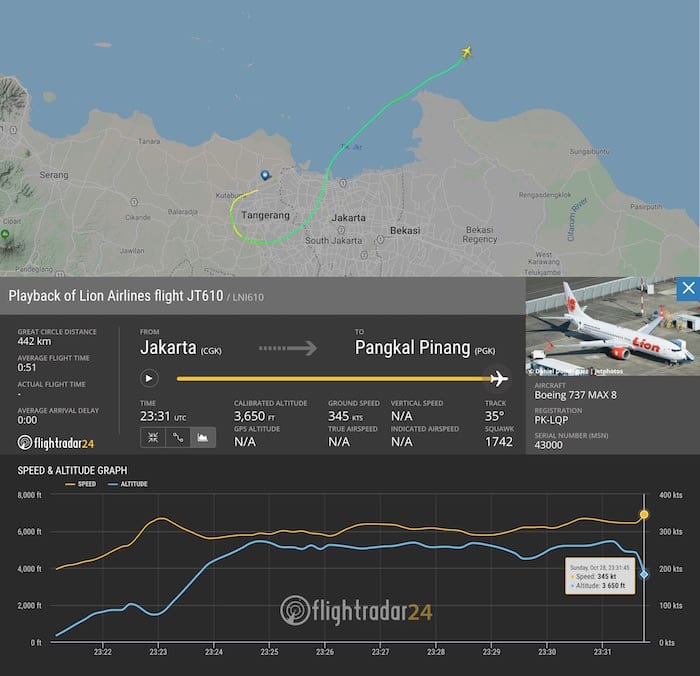
Lion Air JT610 flight data. Image courtesy of Flightradar24
UPDATE: On Friday Nov. 2, 2018, an update on the investigation into Lion Air flight JT610 posted to the Lion Air Group website confirmed that the Indonesian search and rescue agency, Basarnas, has located the flight data recorder (FDR) from the aircraft. The FDR has been submitted to the National Transportation Safety Committee (KNKT).
A Boeing 737 MAX 8 operated by Lion Air as flight JT610 lost contact with Soekarno-Hatta’s air traffic control (ATC) and crashed Monday with 189 total passengers and crew onboard into the Java Sea north of Indonesia’s Java Island.
The cause of the accident has not yet been determined, and Indonesia’s search-and-rescue agency still has not located the aircraft. Here is everything that’s been reported so far about Lion Air flight JT610.
The Lion Air Boeing 737 MAX was flying from Jakarta to Pangkal Pinang on the island of Bangka, airline executives and Indonesian search-and-rescue and accident-investigation officials said during a press conference with reporters at the Soekarno-Hatta Airport. About 13 minutes after taking off, the pilot requested to return to base before the aircraft started losing altitude and plunged into the sea, the officials said.
Global flight-tracking service Flightradar24 published ADS-B tracking data showing how the flight’s last received ADS-B message occurred at an altitude of 425 feet amsl. The aircraft reached an estimated maximum altitude of 5,400 feet before losing contact with air traffic control and eventually crashing.
Indonesian investigators are still trying to determine why the pilot requested a return to base shortly after taking off.
Basarnas, the National Search and Rescue Agency (NSRA) of Indonesia, is still trying to locate the aircraft fuselage, passengers and flight crew along with the aircraft’s flight data and cockpit voice recorders. The agency noted that the aircraft’s emergency locator transmitter (ELT) beacon did not emit a distress signal.
“What is certain, when it falls, the emergency local transmitter (ELT) beacon on the plane does not emit or emit a destress signal. Thus, the crash of the plane was not monitored by the medium-Earth orbital local user terminal (MEO LUT) at the Basarnas Head Office,” the agency said.
Aircraft registration data reported by Flightradar24 shows that the aircraft was a Boeing 737 MAX 8 delivered to Lion Air Aug. 13, 2018, and features CFM LEAP-1B engines.
Boeing issued a statement expressing its “heartfelt sympathies to the families and loved ones of those on board.” The airplane maker is providing assistance under the direction of Indonesian government officials investigating the incident.
A representative for the U.S. National Transportation Safety Board (NTSB) confirmed that the agency is participating in the accident investigation.
“The NTSB is participating as an accredited representative under ICAO Annex 13 since the airframe and engines are both U.S.-manufactured,” Terry Williams, a representative for NTSB, told Avionics International.